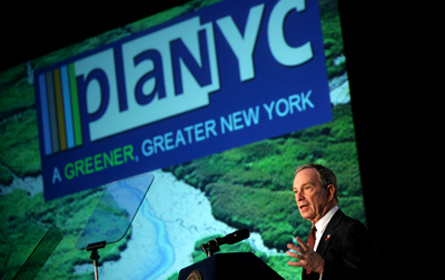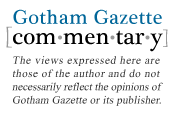

Earth Day -- April 22 -- will mark the third anniversary of PlaNYC2030, Mayor Michael Bloomberg's self-proclaimed "long-term sustainability plan." While the city has taken many steps toward the plan's goal of "a greener greater New York," particularly in energy conservation, one gaping hole remains in the plan.
PlaNYC2030 left out any role for the city's hundreds of neighborhoods, 59 community boards, and the countless civic, community and environmental groups that care about the future of the city. It was a top-down plan, conceived at City Hall with minimal input, and it was never approved as an official plan. In the long term this will only undermine the ability to sustain the plan itself, and both implement and improve it.
The plan now stands at a critical juncture, Rohit Aggarwala, director of the Mayor's Office of Long-term Planning and Sustainability, recently announced his resignation, and the city's budget situation and the overall economic situation have delayed and even derailed some of its initiatives. With Aggarwala's departure and the convening of a commission to review the City Charter, now is the time to fill the gap that excluded neighborhoods. An updated PlaNYC2030 could then be reviewed and voted on by community boards, borough presidents, the City Planning Commission, and City Council, as required in the City Charter.
Gaps in the Planning Process
The problem started in 2007, and it started at the top. You would think that such a daunting task as planning for a city of 8 million people and projecting our priorities over a period of more than two decades would be really difficult and take a long time. Yet it was all done in the time it takes to approve the average rezoning, about seven months.
The mayor's consultants, who completed the plan in record time, never went through any of the steps, outlined in the City Charter, the city’s constitution, that plans must take in order to be approved.
Under Section 197-a of the City Charter, plans should be reviewed and voted on by the affected community boards, borough presidents, the City Planning Commission and the City Council. At each step there must be a public hearing. None of this happened.
One can surely argue that this could be a long and tedious process because the 197-a plan approval process does not have a time limit like the city’s Uniform Land Use Review Procedure, which is used for zoning and other major city actions and generally takes some seven months. However, the delays in approving plans in the past have largely been the result of action (and inaction) by the city’s planning department, an agency the mayor controls. In the two decades since the 1989 charter revision made it easier to submit plans under Section 197-a, only a handful have been approved and almost all of them were initiated not by the city but by community boards, despite a lack of funding and technical support.
Since PlaNYC was never officially approved, it remains an initiative of the mayor, owned and operated by City Hall. Generally, the Department of City Planning is responsible for planning and engaging other branches of government.
The department, however, played a minor role in preparing the 2030 plan, and long-term plans of any kind have been notably absent from City Planning’s portfolio. Instead, the agency touts as one of its top achievements the 100 rezonings it approved in the last eight years.
While the rezonings have opened up opportunities for new development -- also a major goal of PlaNYC2030 -- and protected many other areas, they hardly pass muster as "plans." Rezoning for new development is often done without planning for new schools, transit and other services, nor does it entail measures to deal with existing service deficits or the myriad problems that face communities. In some neighborhoods that have undergone massive rezoning, such as Williamsburg, residents are now up in arms because new high-rise luxury development has overtaxed the capacity of local schools and transit.
While City Planning often echoes PlaNYC's call for "transit-oriented development" by promoting higher density development around subway stops, it does not insure that transit capacity will grow to meet increased needs. Trains and buses are even more overcrowded than they were before the rezoning, and with more service cutbacks planned, the situation promises to get worse. If that's planning it's surely not good planning.
Creating the Plan
Fortunately the 2030 plan looks more like a long-term plan for the city than the 100 piecemeal rezonings, even if they both favor growth over community improvements. But it's still the mayor's plan and not the city's plan and could easily change or disappear under the next mayor. Even though the City Council approved the creation of a permanent office of long-term sustainability, there is no guarantee it will always be adequately funded.
If we look at how the plan came about, we begin to see the problem. PlaNYC was the product of a small group in the Mayor's Office of Operations.
The bulk of the work was done by McKinsey & Company, a global consulting firm, under contract with the city's Economic Development Corp.
The EDC itself is a non-profit wholly owned by the city. It functions as the mayor's proxy in negotiating deals with developers and undergoes minimal oversight. The McKinsey report was not made public -– I received a copy by filing a Freedom of Information request. It appears to have been the core of the PlaNYC, apparently embellished after consultation with specific agencies that have offered their ideas, such as the million trees, and public plaza initiatives. All of the proposals fit into the plan’s giant spreadsheet, a perfect instrument for CEOs and the budget office but not something that most New Yorkers have a chance to work with.
The Missing Pieces
Once the mayor’s office came up with goals and selected projects to put in the long-term plan, the administration held consultations throughout the city and solicited feedback. Despite this, there was no public involvement in making the final decisions about priorities and programs. I must confess that I sat through some of these meetings and focus groups and felt ashamed that the many committed and bright community representatives in the room were treated like subjects in a marketing experiment and not partners in an important civic discussion.
Even if PlaNYC was bottled up in the city's executive offices, it still could have turned out to be a great plan. But because the process was rushed and top-down, many opportunities were missed.
For example, the plan could have penetrated much deeper into the problems of sustainability as they affect all New Yorkers where they live and work. In the end, after weeding through the 127 projects in the plan's matrix, it seems energy efficiency received the highest priority. A review of 2009 mayoral press releases about the 2030 plan by Brian Paul, a fellow at the Hunter College Center for Community Planning and Development, found that two thirds deal with energy efficiency, climate change and efficient transportation.
This is not to say energy or efficiency shouldn’t be top priorities, only that they are closely related in a holistic way to the way we live in our neighborhoods. Without the engagement of neighborhoods, businesses and residents, progress on this front will be slow. The mayor's failed effort at congestion pricing provides dramatic evidence of this. And then there are serious issues of social equity, barely touched upon the 2030 plan.
The problem of sustaining and implementing the plan goes back again to the problem of the planning process. McKinsey’s background in management consulting led it to emphasize issues of efficiency -– particularly with energy. This is clearly the most elaborate element in the long-term plan and, not surprisingly, the area in which the greatest progress seems to have been made in the last three years. The city has purchased hybrid vehicles and passed rules encouraging owners to make their buildings more energy efficient, among other efforts.
But many of the gains, like reducing the wasteful use of city-owned vehicles and reducing traffic in Midtown, could have been done without a plan. At the same time, much less has been done to encourage grassroots efforts in energy efficiency and the use of alternative energy sources. PlaNYC does not include any community-based plans and initiatives to address problems of environmental quality and public health, housing, transportation, and open space. In fact, the 100 community-based plans in the city, most of them ignored and never adopted by the city’s planners, were not even taken into account for PlaNYC.
New Yorkers are most familiar with the neighborhoods where they live and work. In this sense they are specialists, and neighborhood leaders and activists are usually a great source of knowledge. Surely they can be parochial and narrow-minded, but so too can people in government agencies. PlaNYC did not look at the city from the perspective of its hundreds of neighborhoods or incorporate the vast experiences and histories of its neighborhoods. Only after the giant spreadsheet was made were the citywide programs and projects broken down, but mostly for reporting purposes.
The city’s 59 community boards, now struggling to salvage their limited role in decision making, are still invisible in the 2030 plan, barely mentioned in the scores of spreadsheets, maps and colorful images that herald the coming of the green city. They can post comments but play no role in setting priorities or initiating change. They are not consulted until after the fact, yet they are often criticized for only reacting. Civic and advocacy groups, including many that started fighting for a greener and greater future decades ago, and advocated sustainability long before the term was uttered in City Hall, are similarly sidelined.
This is a unique and important time. A fresh approach to long-term sustainability planning at the top could lead to a true partnership between neighborhoods and City Hall. The New York City Charter already provides the framework, and that can be strengthened to insure that all planning is open, transparent and accessible to all, and that the plan belongs to everyone. And that, in turn, will help assure that the plan survives to guide New York to a truly sustainable future.
Tom Angotti is director of the Hunter College Center for Community Planning & Development and author of "New York For Sale" (MIT Press, 2008).




